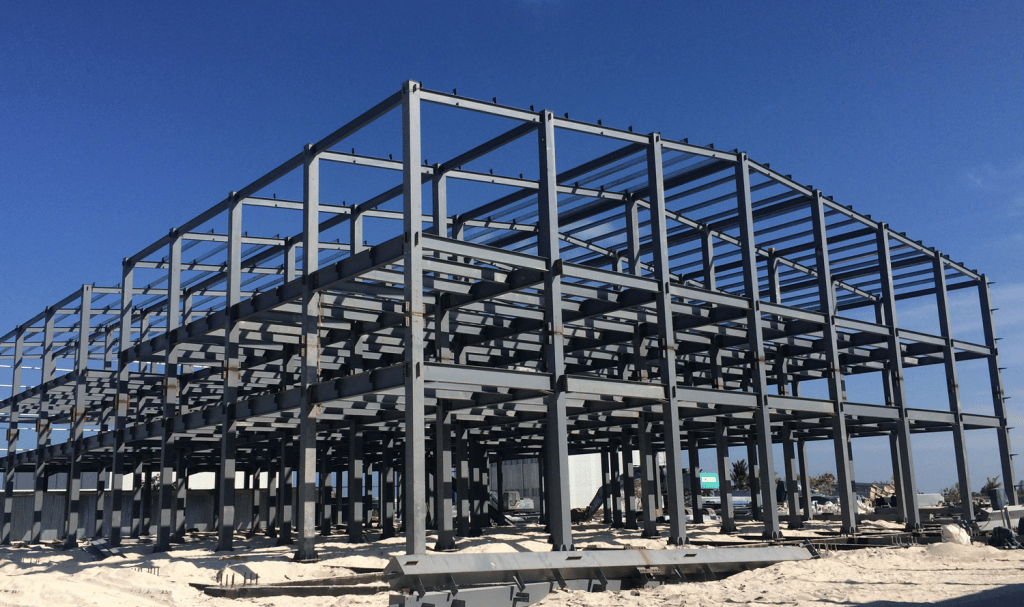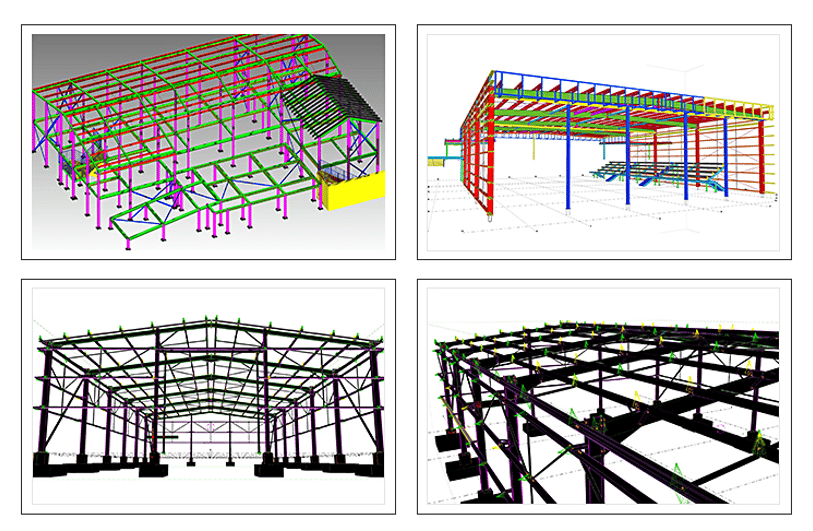Abstract: As the main construction form in architectural design, steel structure is widely used in the design of large workshops, bridges and high-rise buildings. The construction steel used in the steel structure has many advantages such as anti-deformation, corrosion resistance, earthquake resistance and environmental protection requirements, so it can be widely used in the field of architectural design.
When steel structures are used in construction projects, their structural stability, as a crucial indicator, directly determines the quality and service life of buildings. Based on K-home‘s years of architectural design experience, this paper discusses the stability of steel structures in construction engineering and provides references for corresponding issues.

Foreword
In the long development of construction engineering technology, steel structure occupies an important position. At present, as a mainstream architectural structure, it is widely used in various architectural designs, especially in factories, bridges, airports, theaters, super high-rise buildings. and other large buildings.
In the last century, due to the underdeveloped steel smelting technology and the high carbon content of construction steel, its toughness and corrosion resistance made steel structures not valued in the field of architectural design, and were once marginalized and almost eliminated.
In recent years, with the continuous progress of metal smelting technology, high-strength, high-toughness, corrosion-resistant construction steel has been widely produced, and steel structures have been favored by architects again, and are increasingly used in various projects. During construction, it has played a positive role in reducing the overall structural weight of the building and improving the overall safety of the building.
With the continuous development of construction technology, the use of steel structures has become more and more extensive, and various complex use conditions have put forward a severe test for its stability.
The Concept Of Steel Structure
As the name suggests, steel structure is a type of building structure that uses steel as the main raw material for structural construction. Through different steel components such as steel beams, steel plates, and steel columns, welding, riveting and other connection methods are used for splicing and assembly to construct large buildings. Steel structures use various types of steel as the main material.
Different from ordinary concrete and other building materials, steel has the characteristics of light weight, strong toughness, etc., and can withstand greater forces. Therefore, steel structure design is often used in the design of large and medium-sized buildings. The steel structure has a stable structure and is not easily deformed, which can provide good safety and stability for the building. However, in some special cases, the instability of the steel structure may also occur.
There are two common situations: one is that the excessive pressure directly acts on the force balance point, resulting in uneven stress on the structure as a whole. The other is that due to the long-term use of steel structural members, the internal structure has problems such as mental fatigue, and the internal structure loses its supporting function, resulting in the instability of the overall structure.
Before designing a steel structure, it is necessary to clarify the stability characteristics of this structure, so as to have a targeted design process, avoid structural weaknesses, give full play to the advantages of steel structures, and make steel structures in buildings play a better role.
Learn More About Residential Metal Garage Buildings
Principles Of Improving Design Stability Of Steel Structures
The stability of the steel structure is the most important factor in the design of the steel structure. In the long-term engineering practice and theoretical research, the engineers and technicians have summarized three design principles to improve the stability of the steel structure.
1. The Principle Of Stability
The principle of stability of steel structure design requires that in the stage of drawing the plan drawing of the steel structure design, the plan drawing of the steel structure should be drawn according to the corresponding requirements of different buildings, focusing on ensuring the support parts in the plan design drawing of the steel structure and ensuring the support Stability in the plane of the site.
The stability of the steel structure on the plane is the core and foundation of the overall stability of the entire steel structure. Only by ensuring that the components of the steel structure remain stable on the plane can we avoid the instability of individual positions during the subsequent three-dimensional construction process.
2. The Principle Of Unity
Precise calculation is the premise and foundation of steel structure design. When designing steel structure frames, the calculation method and expected parameter values should be determined according to the balanced relationship between the specific frame and the frame.
This step is the key to the force calculation of the entire steel structure design. link. However, in practice, many designers will rely too much on personal experience, and directly perform the stability calculation of the steel structure frame according to their own experience and ignore the balance calculation steps.
This method of operation lacks scientific and comprehensive calculation data, and it is easy to cause errors in the calculation of the stable relationship. As a result, the design of the steel structure fails to meet the structural strength requirements of the building, resulting in potential safety hazards.
Therefore, the equilibrium calculation and the stability calculation need to be carried out at the same time, and the two are indispensable and should be unified.
3. The Principle Of Cooperation
The entire steel structure is composed of multiple single steel structure components through welding, riveting, screw fixing and other connection means, and finally forms a large building structure. [3] Therefore, in the process of steel structure design, the coordination of various structural components must be considered, whether large or small components need to cooperate with each other, and finally can be perfectly combined into a solid steel structure as a whole. In the design of steel structure, the stability of a single steel structure component cannot be considered only, and the conditions of all components must be comprehensively considered, and a precise combination calculation must be carried out. Only when each component is perfectly matched can the entire structure be highly stable, maximize the role of each component, and ensure the overall strength of the structure.
The Key Points Of Steel Structure Stability Design
1. Force Design
One of the most important indicators of a steel structure is its stress level. When designing, the load-bearing capacity of the steel structure is the first consideration.
The steel structure generally adopts a T-shaped or L-shaped design, which is considered the stability of the structure. The use of these two shapes can well disperse the overall weight of the building and achieve the purpose of balanced support.
In the practice of construction engineering, steel structure is a common structure on the periphery of a building, which plays a role in supporting the building. In the overall design of the building, the use of steel structures should follow the principle of symmetry as much as possible.
Further Reading: Steel Structure Installation & Design
The purpose is to allow each steel structure to bear the force of the entire building evenly and to prevent individual steel structures from bearing too much or too little pressure.

In addition, the stress and stability requirements for different parts of the steel structure are also different. For example, the requirement for the fixed support in the steel structure is to prevent displacement, so the supporting capacity of this part is required to be high, but for the steel beam frame, in addition to playing a longitudinal supporting role, it is also necessary to consider preventing it from happening in a horizontal position.
The stress characteristics of different parts of the steel structure should be reflected in the design to avoid instability due to insufficient consideration. Finally, the specific construction operation of the steel structure is also very important. On-site construction personnel must strictly follow the design drawings, minimize construction errors, strengthen mutual cooperation between departments, carry out construction in strict accordance with standards, and strengthen detail management.
2. Anti-Corrosion Design
Buildings will experience erosion under different natural conditions when used in different environments. Under special use environments such as humidity and salt spray, due to the inherent characteristics of metals, they are easily corroded and affect their stability.
In general, metal materials are susceptible to both galvanic corrosion and chemical corrosion. Modern material science has developed anti-corrosion coatings for different environmental conditions for the use environment of metals used in construction.
In a humid environment, smearing anti-corrosion paint on the surface of the steel structure can isolate water and air, two major factors that cause metal corrosion, and prevent the steel structure from being corroded. For steel structures used in high salinity environments, it is easy to cause electrochemical corrosion with sodium ions in seawater.
According to the principle of electrochemical reaction, the metal material becomes one of the products. This method can solve the problem of steel structures. Corrosion problem, so as to ensure the strength of the steel structure itself and achieve the stability of the structure.
3. Stability-Related Design
In the process of steel structure design and construction, in addition to completing the stability calculation, it is also necessary to strengthen the inspection of the entire steel structure. Strict inspection is the key link to ensuring that the steel structure materials are qualified and meet the design requirements. The critical pressure calculation method is a common method for predicting the pressure value of steel structures during actual use and is often used for steel structure testing.
When the measurement result of the stress on the steel structure exceeds the critical value, it proves that its stability has been destroyed, and the stress design of the steel structure needs to be adjusted in time to avoid instability.
Pay attention to the force analysis of each part inside the steel structure, optimize the force details of the parts, avoid the problem of uneven force and affect the overall structural safety. To sum up, the stability of the steel structure has a decisive influence on the overall safety and service life of the building.
In the process of designing the steel structure, the designer should carry out precise calculations, comprehensively consider the force relationship between the components, and do Good anti-corrosion treatment of steel, avoid the shortcomings of steel structure to the greatest extent, and give full play to the advantages of steel structure, thereby promoting the continuous progress of the architectural design.
Contact Us >>
Have questions or need help? Before we start, you should know that almost all prefab steel buildings are customized.
Our engineering team will design it according to local wind speed, rain load, length*width*height, and other additional options. Or, we could follow your drawings. Please tell me your requirement, and we will do the rest!
Use the form to reach out and we will be in touch with you as quickly as possible.
About Author: K-HOME
K-home Steel Structure Co., Ltd covers an area of 120,000 square meters. We are engaged in the design, project budget, fabrication, and installation of PEB steel structures and sandwich panels with second-grade general contracting qualifications. Our products cover light steel structures, PEB buildings, low-cost prefab houses, container houses, C/Z steel, various models of color steel plate, PU sandwich panels, eps sandwich panels, rock wool sandwich panels, cold room panels, purification plates, and other construction materials.
